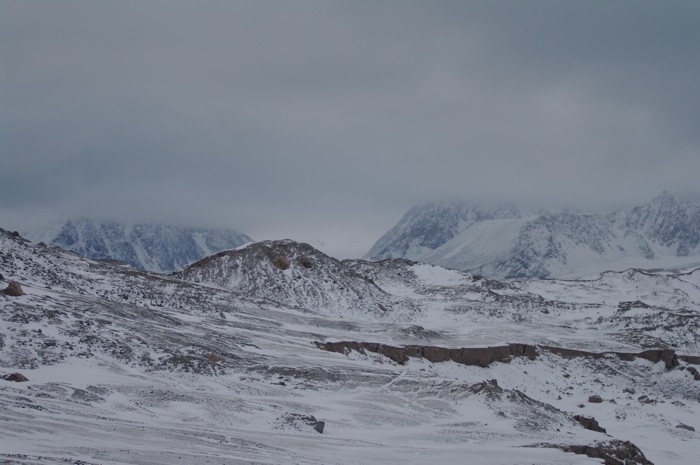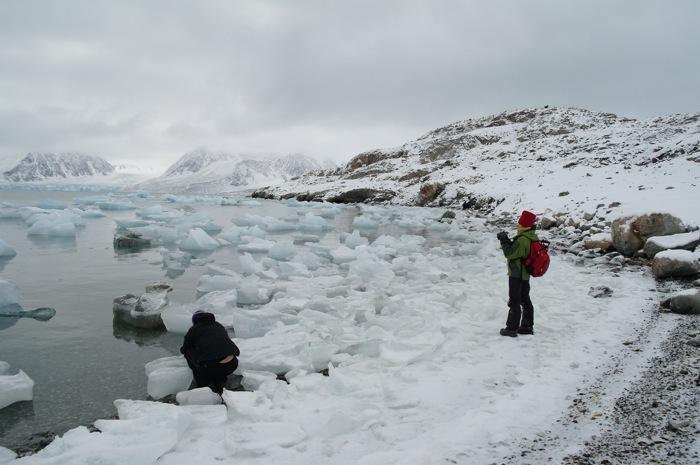16 October 2010 – Erikbreen, Liefdefjorden
We’re in the Liefdefjorden now – the Lover’s fjord. It’s named after a ship. It’s near here that Christiane Ritter lived with her trapper husband in the 1930s – at Gråhuken.
At our downstairs dinner table there is a running joke about my supposed search for a ‘hairy trapper’ to spend a winter with here. Because I want to find a way to come back. Local lore abounds with tales of trappers cruising Longyearbyen looking for a woman to stay with them – and women saying yes to a stranger and heading out into the wilderness… Across the fjord at Mushamna there is boat on which such a couple lives now – true story – though he is an independent scientist, not a hunter. While I’m not interested in full beards or fox-traps, these stories are exciting and romantic – why?
…To be here, I think, requires some kind of straddling of safety and wildness; it’s as though you have to put yourself out on a limb, to cross some kind of line, to really be here, and not simply be looking from the outside. To live in a hut on the shore is a real option here – very few have permission to do so, but there are a handful every year who do it. The fantasy of two people, especially two strangers, becoming intimate amid the ice and darkness, is a potent one. It resonates because everything is already at the edge here – the ‘trapper’ fantasy is as much a brush with the sublime as an encounter with a polar bear. In reality, probably not desirable, but tinged with excitement and the awesome possibility of ‘living to tell the tale’.
 Waiting on the deck to go ashore, I notice that the snow is landing on the black rail and not melting; landing in singular flakes that are visibly starred, perfect as child’s glitter, an elaborate confetti. I think back to Moffen Island: its cream-white coat, then, is the result of all these stars piled endlessly up, drifting around the lagoon, layering the beach, melting on the water, packing into crevices. Stars, stars. All this landscape, the mountains and the glaciers, packed and coated and painted with tiny, countless stars.
Waiting on the deck to go ashore, I notice that the snow is landing on the black rail and not melting; landing in singular flakes that are visibly starred, perfect as child’s glitter, an elaborate confetti. I think back to Moffen Island: its cream-white coat, then, is the result of all these stars piled endlessly up, drifting around the lagoon, layering the beach, melting on the water, packing into crevices. Stars, stars. All this landscape, the mountains and the glaciers, packed and coated and painted with tiny, countless stars.
 Ashore at Hornbaekpollen and around the moraine at Erikbreen. An amazing, three-hour hike over endless rubble coated in snow. It is huge, not simply a ring of bulldozed stones and boulders at the end of the glacier’s path, but a whole territory of hills in a high arc right around the frozen moraine lake.
Ashore at Hornbaekpollen and around the moraine at Erikbreen. An amazing, three-hour hike over endless rubble coated in snow. It is huge, not simply a ring of bulldozed stones and boulders at the end of the glacier’s path, but a whole territory of hills in a high arc right around the frozen moraine lake.
We clamber up and down steep slopes, loose rock-piles, bits of tundra and whole surfaces of higgledy piggledy stones with no clay between them; just dangerous, ankle-grabbing gaps filled deceptively with snow. There are gullies full of snow, how deep one cannot tell; places where a bear might be lying quiet, under that snow, resting.They are hungry now, Jan says. They can only hunt once the pack ice comes: it gives them a floating platform for catching seals.
Along the high ridges, we walk on knife-like edges that tip away down either side in long sweeps of dried mud or swathes of snow. And at the far extent of our walk, recent bear tracks.
 Mountains and more mountains, those in the distance glowing in the sun, those inland white and imposing, grandmothering all the rest. The nearest are the sentinals for the glaciers – there is barely a pair of mountains that is not draped around the ankles with a glacier’s pale train. Erikbreen flows into its enormous, frozen lake like a great paw stretched out from between the peaks. From our high ridges we can see the tiny figures of our colleagues, down on the lake, filming.
Mountains and more mountains, those in the distance glowing in the sun, those inland white and imposing, grandmothering all the rest. The nearest are the sentinals for the glaciers – there is barely a pair of mountains that is not draped around the ankles with a glacier’s pale train. Erikbreen flows into its enormous, frozen lake like a great paw stretched out from between the peaks. From our high ridges we can see the tiny figures of our colleagues, down on the lake, filming.
 At the tiny bay where we rest before returning, a long view to the vast wall of Monacobreen and its smaller neighbour. In this little bay, chunks of white and blue ice clinking and bubbling, as well as making strange, electronic whistles, like surreal dolphin squeaks. I imagine it without us – the ice quietly talking to itself, all day, all night, all the time; clinking and melting, floating, flowing.
At the tiny bay where we rest before returning, a long view to the vast wall of Monacobreen and its smaller neighbour. In this little bay, chunks of white and blue ice clinking and bubbling, as well as making strange, electronic whistles, like surreal dolphin squeaks. I imagine it without us – the ice quietly talking to itself, all day, all night, all the time; clinking and melting, floating, flowing.



